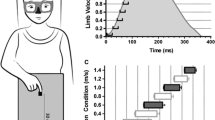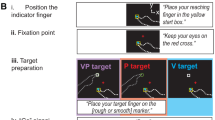Abstract
When performing upper limb reaches, the sensorimotor system can adjust to changes in target location even if the reaching limb is not visible. To accomplish this task, sensory information about the new target location and the current position of the unseen limb are used to program online corrections. Previous researchers have argued that, prior to the initiation of corrections, somatosensory information from the unseen limb must be transformed into a visual reference frame. However, most of these previous studies involved movements to visual targets. The purpose of the present study was to determine if visual sensorimotor transformations are also necessary for the online control of movements to somatosensory targets. Participants performed reaches towards somatosensory and visual targets without vision of their reaching limb. Target positions were either stationary, or perturbed before (~ 450 ms), or after movement onset (~ 100 ms or ~ 200 ms). In response to target perturbations after movement onset, participants exhibited shorter correction latencies, larger correction magnitudes, and smaller movement endpoint errors when they reached to somatosensory targets as compared to visual targets. Because reference frame transformations have been shown to increase both processing time and errors, these results indicate that hand position was not transformed into visual reference frame during online corrections for movements to somatosensory targets. These findings support the idea that different sensorimotor transformations are used for the online control of movements to somatosensory and visual targets.






Similar content being viewed by others
References
Ambrosini E, Ciavarro M, Pelle G et al (2012) Behavioral investigation on the frames of reference involved in visuomotor transformations during peripheral arm reaching. PLoS One 7:e51856. https://doi.org/10.1371/journal.pone.0051856
Bard C, Turrell Y, Fleury M et al (1999) Deafferentation and pointing with visual double-step perturbations. Exp Brain Res 125:410–416. https://doi.org/10.1007/s002210050697
Battaglia-Mayer A, Caminiti R, Lacquaniti F, Zago M (2003) Multiple levels of representation of reaching in the parieto-frontal network. Cereb Cortex 13:1009–1022. https://doi.org/10.1093/cercor/13.10.1009
Bernier P-M, Gauthier GM, Blouin J (2007) Evidence for distinct, differentially adaptable sensorimotor transformations for reaches to visual and proprioceptive targets. J Neurophysiol 98:1815–1819. https://doi.org/10.1152/jn.00570.2007
Bernier P-M, Burle B, Vidal F et al (2009) Direct evidence for cortical suppression of somatosensory afferents during visuomotor adaptation. Cereb Cortex 19:2106–2113. https://doi.org/10.1093/cercor/bhn233
Blangero A, Rossetti Y, Honoré J, Pisella L (2005) Influence of gaze direction on pointing to unseen proprioceptive targets. Adv Cogn Psychol 1:9–16. https://doi.org/10.2478/v10053-008-0039-7
Blouin J, Saradjian AH, Lebar N et al (2014) Opposed optimal strategies of weighting somatosensory inputs for planning reaching movements toward visual and proprioceptive targets. J Neurophysiol 112:2290–2301. https://doi.org/10.1152/jn.00857.2013
Bock O (1986) Contribution of retinal versus extraretinal signals towards visual localization in goal-directed movements. Exp Brain Res 64:476–482. https://doi.org/10.1007/BF00340484
Buneo CA, Andersen RA (2006) The posterior parietal cortex: sensorimotor interface for the planning and online control of visually guided movements. Neuropsychologia 44:2594–2606. https://doi.org/10.1016/j.neuropsychologia.2005.10.011
Burnod Y, Baraduc P, Battaglia-Mayer A et al (1999) Parieto-frontal coding of reaching: an integrated framework. Exp Brain Res 129:325–346. https://doi.org/10.1007/s002210050902
Carlton LG (1992) Visual processing time and the control of movement. In: Proteau L, Elliott D (eds) Advances in psychology. North-Holland, Oxford, pp 3–31
Dadarlat MC, O’Doherty JE, Sabes PN (2015) A learning-based approach to artificial sensory feedback leads to optimal integration. Nat Neurosci 18:138–144. https://doi.org/10.1038/nn.3883
Day BL, Lyon IN (2000) Voluntary modification of automatic arm movements evoked by motion of a visual target. Exp Brain Res 130:159–168. https://doi.org/10.1007/s002219900218
Desmurget M, Pélisson D, Rossetti Y, Prablanc C (1998) From eye to hand: planning goal-directed movements. Neurosci Biobehav Rev 22:761–788. https://doi.org/10.1016/S0149-7634(98)00004-9
Elliott D, Carson RG, Goodman D, Chua R (1991) Discrete vs. continuous visual control of manual aiming. Hum Mov Sci 10:393–418. https://doi.org/10.1016/0167-9457(91)90013-N
Goodale MA, Pelisson D, Prablanc C (1986) Large adjustments in visually guided reaching do not depend on vision of the hand or perception of target displacement. Nature 320:748–750. https://doi.org/10.1038/320748a0
Goodman R, Crainic VA, Bested SR et al (2018) Amending ongoing upper-limb Reaches: Visual and proprioceptive contributions? Multisensory Res 31:455–480. https://doi.org/10.1163/22134808-00002615
Heath M (2005) Role of limb and target vision in the online control of memory-guided reaches. Mot Control 9:281–311
Henriques DY, Klier EM, Smith MA et al (1998) Gaze-centered remapping of remembered visual space in an open-loop pointing task. J Neurosci 18:1583–1594. https://doi.org/10.1523/JNEUROSCI.18-04-01583.1998
Hulliger M (1984) The mammalian muscle spindle and its central control. In: Reviews of physiology, biochemistry and pharmacology, vol 101. Springer Berlin Heidelberg, Berlin, pp 1–110
Johnson H, Van Beers RJ, Haggard P (2002) Action and awareness in pointing tasks. Exp Brain Res 146:451–459. https://doi.org/10.1007/s00221-002-1200-z
Jones SAH, Henriques DYP (2010) Memory for proprioceptive and multisensory targets is partially coded relative to gaze. Neuropsychologia 48:3782–3792. https://doi.org/10.1016/j.neuropsychologia.2010.10.001
Kennedy A, Bhattacharjee A, Hansen S et al (2015) Online vision as a function of real-time limb velocity: another case for optimal windows. J Mot Behav 47:465–475. https://doi.org/10.1080/00222895.2015.1012579
Komilis E, Pélisson D, Prablanc C (1993) Error processing in pointing at randomly feedback-induced double-step stimuli. J Mot Behav 25:299–308. https://doi.org/10.1080/00222895.1993.9941651
Lacquaniti F, Soechting JF (1986) EMG responses to load perturbations of the upper limb: effect of dynamic coupling between shoulder and elbow motion. Exp Brain Res 61:482–496. https://doi.org/10.1007/BF00237573
Manson GA, Alekhina M, Srubiski SL et al (2014) Effects of robotic guidance on sensorimotor control: Planning vs. online control? Neuro Rehabilitation 35:689–700. https://doi.org/10.3233/NRE-141168
McGuire LMM, Sabes PN (2009) Sensory transformations and the use of multiple reference frames for reach planning. Nat Neurosci 12:1056–1061. https://doi.org/10.1038/nn.2357
Miller JO, Low K (2001) Motor processes in simple, go/no-go, and choice reaction time tasks: a psychophysiological analysis. J Exp Psychol Hum Percept Perform 27:266–289
Mueller S, Fiehler K (2014) Effector movement triggers gaze-dependent spatial coding of tactile and proprioceptive-tactile reach targets. Neuropsychologia 62:184–193. https://doi.org/10.1016/j.neuropsychologia.2014.07.025
Oldfield RC (1971) The assessment and analysis of handedness: the Edinburgh inventory. Neuropsychologia 9:97–113
Oostwoud Wijdenes L, Brenner E, Smeets JBJ (2011) Fast and fine-tuned corrections when the target of a hand movement is displaced. Exp Brain Res 214:453–462. https://doi.org/10.1007/s00221-011-2843-4
Oostwoud Wijdenes L, Brenner E, Smeets JBJ (2013) Comparing online adjustments to distance and direction in fast pointing movements. J Mot Behav 45:395–404. https://doi.org/10.1080/00222895.2013.815150
Oostwoud Wijdenes L, Brenner E, Smeets JBJ (2014) Analysis of methods to determine the latency of online movement adjustments. Behav Res Methods 46:131–139. https://doi.org/10.3758/s13428-013-0349-7
Pélisson D, Prablanc C, Goodale MA, Jeannerod M (1986) Visual control of reaching movements without vision of the limb. II. Evidence of fast unconscious processes correcting the trajectory of the hand to the final position of a double-step stimulus. Exp Brain Res 62:303–311. https://doi.org/10.1007/BF00238849
Pouget A, Ducom JC, Torri J, Bavelier D (2002) Multisensory spatial representations in eye-centered coordinates for reaching. Cognition 83:B1–B11
Prablanc C, Martin O (1992) Automatic control during hand reaching at undetected two-dimensional target displacements. J Neurophysiol 67:455–469. https://doi.org/10.1152/jn.1992.67.2.455
Prevosto V, Graf W, Ugolini G (2010) Cerebellar inputs to intraparietal cortex areas LIP and MIP: functional frameworks for adaptive control of eye movements, reaching, and arm/eye/head movement coordination. Cereb Cortex 20:214–228. https://doi.org/10.1093/cercor/bhp091
Prevosto V, Graf W, Ugolini G (2011) Proprioceptive pathways to posterior parietal areas MIP and LIPv from the dorsal column nuclei and the postcentral somatosensory cortex. Eur J Neurosci 33:444–460. https://doi.org/10.1111/j.1460-9568.2010.07541.x
Redon C, Hay L, Velay JL (1991) Proprioceptive control of goal-directed movements in man, studied by means of vibratory muscle tendon stimulation. J Mot Behav 23:101–108. https://doi.org/10.1080/00222895.1991.9942027
Reichenbach A, Thielscher A, Peer A et al (2009) Seeing the hand while reaching speeds up on-line responses to a sudden change in target position. J Physiol 587:4605–4616. https://doi.org/10.1113/jphysiol.2009.176362
Reichenbach A, Thielscher A, Peer A et al (2014) A key region in the human parietal cortex for processing proprioceptive hand feedback during reaching movements. Neuroimage 84:615–625. https://doi.org/10.1016/j.neuroimage.2013.09.024
Sarlegna FR, Mutha PK (2015) The influence of visual target information on the online control of movements. Vision Res 110:144–154. https://doi.org/10.1016/j.visres.2014.07.001
Sarlegna FR, Sainburg RL (2007) The effect of target modality on visual and proprioceptive contributions to the control of movement distance. Exp Brain Res 176:267–280. https://doi.org/10.1007/s00221-006-0613-5
Sarlegna FR, Blouin J (2010) Visual guidance of arm reaching: online adjustments of movement direction are impaired by amplitude control. J Vis 10:24. https://doi.org/10.1167/10.5.24
Sarlegna FR, Przybyla A, Sainburg RL (2009) The influence of target sensory modality on motor planning may reflect errors in sensori-motor transformations. J Neurosci 164:597–610. https://doi.org/10.1016/j.biotechadv.2011.08.021.Secreted
Sober SJ, Sabes PN (2005) Flexible strategies for sensory integration during motor planning. Nat Neurosci 8:490–497. https://doi.org/10.1038/nn1427
Saunders JA, Knill DC (2003) Humans use continuous visual feedback from the hand to control fast reaching movements. Exp Brain Res 152:341–352. https://doi.org/10.1007/s00221-003-1525-2
Saunders JA, Knill DC (2004) Visual feedback control of hand movements. J Neurosci 24:3223–3234. https://doi.org/10.1523/JNEUROSCI.4319-03.2004
Smeets JB, Erkelens CJ, Denier van der Gon JJ (1990) Adjustments of fast goal-directed movements in response to an unexpected inertial load. Exp Brain Res 81:303–312. https://doi.org/10.1007/BF00228120
Smeets JB, Oostwoud Wijdenes L, Brenner E (2016) Movement adjustments have short latencies because there is no need to detect anything. Mot Control 20:137–148. https://doi.org/10.1123/mc.2014-0064
Thompson AA, Glover CV, Henriques DYP (2012) Allocentrically implied target locations are updated in an eye-centred reference frame. Neurosci Lett 514:214–218. https://doi.org/10.1016/j.neulet.2012.03.004
Thompson AA, Byrne PA, Henriques DYP (2014) Visual targets aren’t irreversibly converted to motor coordinates: eye-centered updating of visuospatial memory in online reach control. PLoS One 9:e92455. https://doi.org/10.1371/journal.pone.0092455
Tremblay L, Crainic VA, de Grosbois J et al (2017) An optimal velocity for online limb-target regulation processes? Exp Brain Res 235:29–40. https://doi.org/10.1007/s00221-016-4770-x
Veerman MM, Brenner E, Smeets JBJ (2008) The latency for correcting a movement depends on the visual attribute that defines the target. Exp Brain Res 187:219–228. https://doi.org/10.1007/s00221-008-1296-x
Zelaznik HZ, Hawkins B, Kisselburgh L (1983) Rapid visual feedback processing in single-aiming movements. J Mot Behav 15:217–236. https://doi.org/10.1080/00222895.1983.10735298
Acknowledgements
The authors gratefully acknowledge Intishar Kazi for his help during data collection and Stephen Bested for the design of Fig. 1. The authors also acknowledge Damian Manzone and Sadiya Abdulrabba for providing helpful comments on the manuscript. This work was funded by the Natural Sciences and Engineering Research Council of Canada, the Canadian Foundation for Innovation, the Ontario Research Fund, and Campus France.
Author information
Authors and Affiliations
Corresponding author
Electronic supplementary material
Below is the link to the electronic supplementary material.
Rights and permissions
About this article
Cite this article
Manson, G.A., Blouin, J., Kumawat, A.S. et al. Rapid online corrections for upper limb reaches to perturbed somatosensory targets: evidence for non-visual sensorimotor transformation processes. Exp Brain Res 237, 839–853 (2019). https://doi.org/10.1007/s00221-018-5448-3
Received:
Accepted:
Published:
Issue Date:
DOI: https://doi.org/10.1007/s00221-018-5448-3




